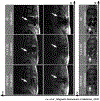Off-resonance artifact correction for MRI: A review
- PMID: 36326709
- PMCID: PMC10284460
- DOI: 10.1002/nbm.4867
Off-resonance artifact correction for MRI: A review
Abstract
In magnetic resonance imaging (MRI), inhomogeneity in the main magnetic field used for imaging, referred to as off-resonance, can lead to image artifacts ranging from mild to severe depending on the application. Off-resonance artifacts, such as signal loss, geometric distortions, and blurring, can compromise the clinical and scientific utility of MR images. In this review, we describe sources of off-resonance in MRI, how off-resonance affects images, and strategies to prevent and correct for off-resonance. Given recent advances and the great potential of low-field and/or portable MRI, we also highlight the advantages and challenges of imaging at low field with respect to off-resonance.
© 2022 The Authors. NMR in Biomedicine published by John Wiley & Sons Ltd.
Figures










References
-
- Lüdeke KM, Röschmann P, and Tischler R. Susceptibility artefacts in NMR imaging. Magnetic Resonance Imaging, 3(4):329–343, January 1985. - PubMed
-
- O’Donnell M and Edelstein WA. NMR imaging in the presence of magnetic field inhomogeneities and gradient field nonlinearities. Medical Physics, 12(1):20–26, January 1985. - PubMed
-
- Michiels J, Bosmans H, Pelgrims P, Vandermeulen D, Gybels J, Marchal G, and Suetens P. On the problem of geometric distortion in magnetic resonance images for stereotactic neurosurgery. Magnetic Resonance Imaging, 12(5):749–765, 1994. - PubMed
-
- Ladd Mark E., Erhart Peter, Debatin Jörg F., Romanowski Benjamin J., Boesiger Peter, and Graeme C McKinnon. Biopsy needle susceptibility artifacts. Magnetic Resonance in Medicine, 36(4):646–651, October 1996. - PubMed
Publication types
MeSH terms
Grants and funding
LinkOut - more resources
Full Text Sources
Other Literature Sources
Medical

